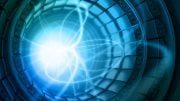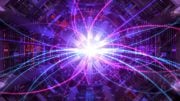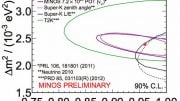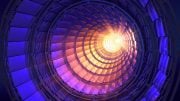
Scientists study neutrinos produced by nuclear reactors, radioactive decay, particle accelerators, the sun, the Earth, and the cosmos. Credit: Artwork by Sandbox Studio, Chicago with Ana Kova
Perhaps the best-named particle in the Standard Model of Particle Physics is the neutrino: it is tiny, neutral, and weighs so little that no one has been able to measure its mass. Neutrinos are the most abundant particles that have mass in the universe. Every time atomic nuclei come together (like in the sun) or break apart (like in a nuclear reactor), they produce neutrinos. Even a banana emits neutrinos—they come from the natural radioactivity of the potassium in the fruit.
Once produced, these ghostly particles almost never interact with other matter. Tens of trillions of neutrinos from the sun stream through your body every second, but you can’t feel them.
Theorists predicted the neutrino’s existence in 1930, but it took experimenters 26 years to discover the particle. Today, scientists are trying to determine the neutrino’s mass, how it interacts with matter, and whether the neutrino is its own antiparticle (a particle with the same mass but opposite electric or magnetic properties) or not. Some scientists think neutrinos might be why all antimatter (the antiparticles of all matter) disappeared after the Big Bang, leaving us in a universe made of matter.
Neutrino Facts
- Scientists named the three types of neutrinos they have discovered so far for the other matter particles they interact with: the electron neutrino, muon neutrino, and tau neutrino.
- Neutrinos change between types as they travel, something scientists call neutrino oscillation.
DOE Office of Science: Contributions to Neutrino Science
The Department of Energy’s support for neutrino science has led to many surprising—and Nobel Prize-winning—discoveries. Today’s investments continue that legacy through experiments and U.S.-hosted international facilities. For example, the KATRIN experiment aims to directly measure the neutrino mass. Other experiments, including PROSPECT and the Fermilab Short-Baseline Neutrino program, use neutrinos from reactors and accelerators to search for unknown types of neutrinos beyond the three that scientists have discovered so far. Scientists are using the MAJORANA Demonstrator experiment deep under the Earth’s surface to determine whether neutrinos are their own antiparticles or not. Still, other neutrino experiments, including NOvA and the upcoming international Deep Underground Neutrino Experiment, study a phenomenon called “neutrino oscillation,” which looks at how mass differs between different types of neutrinos.








The human body also radiates neutrinos, just like a banana. I sometimes wonder what sort of tracks we leave in the space-time continuum. Do the neutrino trails contain information?
Silly scientists. Everyone knows a neutrino is an Italian neutron.
Are organic neutrinos slower than others and is speed a factor in the perceived weight eV
i love science & technology